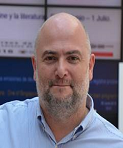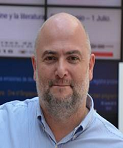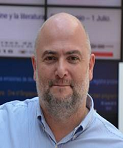Day 1 :
Keynote Forum
Massimo Cecaro
Italian Medical Press Association, Italy
Keynote: Evolution of the Massi care model nd prevention in the area of food safety 2.0 using augmented reality
Time : 10:05-10:40

Biography:
Massimo Cecaro after completing his high school in humanistic studies, he moved to the University of Camerino, where he got a Master’s Degree in Veterinary Medicine and in University of Teramo he successfully got the Specialization. He obtained a qualification to practice as a Journalist and in 2007 he was admitted to the National Association of Medical Press (ASMI), where he currently hold the position of Vice President and General Secretary. He is Resident Member of MJA Medical Journalists’ Association (London). He is a member of EFSA's expert database and has been an invited speaker, mentor and chairman at international events in the field of Public Health and Safety in Canada, US, Europe and Asia. He has authored several scientific works in public health and he is also a Director in Italy of a prestigious educational centre for work safety and public health. He is actively involved in international projects to improve the role of mass-media in medical sciences, and awarded in Philadelphia, Valencia and Las Vegas with international special recognition. He is serving as an Editorial Member of several reputed journals.
Abstract:
The speed of information in recent years has become a necessity for the consumer. Clear and timely guidance must be provided taking into account scientific developments and technological progress. The evolution of the MassiCare model would allow a new model of risk analysis to cross data and metadata. The elements considered are age of the subject, sex, geographical position (which would indicate alarms, such as reminders from the competent authorities in the areas of interest), acute and chronic illnesses, convalescence. Other elements considered are the type of work activity carried out, the training acquired in food safety, which type of food is preferred and the possible cooking temperature. All these details give back a theoretical model of considerable help for the consumer in matters of food safety. The new "MassiCare AR" model, incorporates and analyzes the aforementioned elements by returning data with graphics based also on virtual images. The result of the risk assessment with augmented reality AR will be returned. On the food itself and/or on a mobile device information such as the tolerated safe dose for each individual subject or specific restrictions may be accessed. In addition to this valuable information, you can also access information about allergens.
Keynote Forum
Rong Murphy
Maple Leaf Farms, USA
Keynote: Impact of new food trends to food safety and quality in food manufacturing organizations

Biography:
Rong Murphy is the Vice President of Quality Assurance and Food Safety at Maple Leaf Farms, Inc., America’s leading producer of premium quality duck products. Previously, she served as the Vice President of Food Safety for McDonald’s (China) and in various capacities at PepsiCo, Cargill, and Campbell Soup Company. She started her Food Professional career as a faculty at the University of Arkansas. She received her PhD in Chemical Engineering and her Master of Science degree in Chemical Engineering, Food Science, and Microbiology. She is a registered and licensed Professional Engineer.
Abstract:
There is an insatiable consumer-appetite for organic, all natural, non-GMO, antibiotic free, and gluten free foods, with productions in that market segment estimated to grow by as much as 16% annually through 2020. With more food startup companies claiming organic, all natural, non-GMO, antibiotic free, and gluten free foods at unprecedented rates and major food companies pivoting to offer new products in those categories, the compositions of our foods are shifting. With this market shift, artificial preservatives, colors and dyes as well as those food ingredients that are perceived as consumer-unfriendly are being eliminated from both human and animal food products. How does this shift in food trends impact our food supply? How does this market shift modify the shelf life of our food products? and, how does this shift affect food manufacturing organizations? Food researchers and industries are hard at work to validate the food safety of these new trendy products. As new food products enter the consumer market, food manufactures will need to avoid costly recalls and potential consumer health issues by verifying food safety of products on the frontend. As food manufacturing organizations approach production, the organizations also face more considerations about various costs, quality control, and record keeping. From sourcing to packaging and further to tracking, food ingredients and finished food products are coming from all over the world. Collaboration among supply chain partners and full integration throughout networks of suppliers and customers are critical elements. Food companies that have fully integrated supply chain and customer networks are more likely to succeed, with access to the same information, working towards shared missions to deliver results, and being ahead of their competitors. Connected supplier and customer networks will allow food companies to be agile when faced with issues, responsive to recalls, and to be flexible and efficient.
- Workshop

Chair
Jose S Torrecilla
Complutense University Madrid, Spain
Session Introduction
Jose S Torrecilla
Complutense University Madrid, Spain
Title: Application of mathematical algorithms to protect the quality of food

Biography:
Abstract:
- Workshop on Application of mathematical algorithms to protect the quality of food
Location: Athina 1
Session Introduction
Jose S Torrecilla
Complutense University Madrid, Spain
Title: Application of mathematical algorithms to protect the quality of food

Biography:
Abstract:
- Special Session
Session Introduction
Charalampos Proestos
National and Kapodistrian University of Athens, Greece
Title: HMF and diastase activity in honeys: Analysis and chemometrics for identification of honey freshness and adulteration

Biography:
Abstract:
- Sessions: Food Safety, Quality & Policy | Food Spoilage & Preservation | Food Poisoning & its Control Foodborne Pathogen | Environmental Protection Co-Management with Food Safety

Chair
Charalampos Proestos
University of Athens, Greece

Co-Chair
Guzin Iplikcioglu Cil
Ankara University, Turkey
Session Introduction
Agnieszka Jackowska-Tracz
Warsaw University of Life Sciences, Poland
Title: Antimicrobial activity of nanosized graphene and titanium oxides- its role in food processing hygiene improvement

Biography:
Abstract:

Biography:
Abstract:

Biography:
Abstract:
Methodology: In the study conventional cultivation and immunomagnetic separation (IMS) based cultivation techniques were used for the isolation of Salmonella from 330 chicken samples. The isolates verified as Salmonella spp. by the detection of oriC gene and identified with using malic acid dehydrogenase and DT104 specific primers as S. typhimurium and S. typhimurium DT104, respectively by PCR. The antibiotic susceptibility test of Salmonella isolates was performed with the disc diffusion method with 20 different antibiotics.
Findings: Ninety-six (29.1 %) of the samples were detected as contaminated with Salmonella spp. According to the results 11 isolates (11.4%) were identified as S. typhimurium. None of these serotypes were determined as specific phage type DT104. InvA gene was detected from all the (100.0 %) Salmonella isolates and 14 isolates (14.6 %) were detected as positive for spvC gene. 83 isolates (86.4 %) were resistant to at least 5, 70 isolates (72.9 %) resistant to at least 7, 36 isolates (37.5 %) were resistant to at least 9 antibiotics.
Conclusion & Significance: In conclusion, continuous monitoring of Salmonella prevalence and resistance in the food supply is necessary because of the public health implications of a potential hazard.
Eleni Kollia
National and Kapodistrian University of Athens, Greece
Title: Cynara cardunculus L. and Cistus incanus L. as aflatoxin B1 suppressors on food matrices (sesame seeds & macadamia nuts)

Biography:
Abstract:
Methodology & Theoretical Orientation: The aim of this study was to investigate the anti-aflatoxigenic efficacy of Cynara cardunculus L. and Cistus incanus L. extracts in inoculated with A. parasiticus fatty food matrices. Specifically, sesame seeds and macadamia nuts were selected as substrates for the investigation of the anti-aflatoxigenic ability of C. cardunculus L. and C. incanus L. respectively. The anti-aflatoxigenic efficacy of the two plants was also investigated in the microbiological medium yeast extract sucrose (YES). Moreover, two different HPLC methods for AFB1 determination in sesame seeds and macadamia nuts were developed and validated.
Findings: The results showed that C. cardunculus L. displayed a complete inhibition of AFB1 both in sesame seeds (99.2–99.9%) and in YES medium (97.8–99.9%) while C. incanus L. inhibited the AFB1 production in percentage of 72.5-85.9% for macadamia nuts and in a percentage of 87.1-90.1% for YES medium.
Conclusion & Significance: The anti-aflatoxigenic extracts studied in this work, can be possibly used for reducing or preventing pre/post-harvest AF production and combined with good agricultural, manufacturing and storage practices could lead to a product of guaranteed quality and safety.
Olga Fysun
Technical University of Munich, Germany
Title: Detection and evaluation of biofilms in dairy processing equipment

Biography:
Abstract:
Ioannis Karapanos
Agricultural University of Athens, Greece
Title: Quality and dietary characteristics of cowpea fresh pods from accessions cultivated in southern Europe

Biography:
Abstract:
- Workshop
Session Introduction
Thiago Zilli
Food Safety Council Coordinator, Brazil
Title: Supermarkets role on society: Food safety and security

Biography:
Abstract:
- Special Session
Session Introduction
Cristina Lopez
Veterinary College, Uruguay
Title: Microbiological quality of vacuum-packed and refrigerated beef

Biography:
Abstract:
- Food, Nutrition & Health | Characterization of Food Hazard | Biotechnological Exploitation in Food Safety | Food Safety Regulatory Affairs | Challenges of Food Safety & Hygiene

Chair
Ioannis Karapanos
Agricultural University of Athens, Greece

Co-Chair
Dimitra Gennimata
National School of Public Health, Greece
Session Introduction
Charalampos Proestos
National and Kapodistrian University of Athens, Greece
Title: NMR metabolomics and spectrophotometric studies to infusions and decoctions of plant species to assess and compare the metabolic and antioxidant profiles

Biography:
Abstract:
Dimitra Gennimata
National School of Public Health, Greece
Title: Innovation in food hygiene and safety: Could education play a role?

Biography:
Abstract:
Derek Watson
University of Sunderland, UK
Title: Brexit and the implications of food safety cultural compliance in the food manufacturing sector

Biography:
Abstract:
Findings:The data collected clearly indicates a commitment to food safety compliance. However, the majority of organizations struggled to maintain consistent levels of food safety compliance despite implementing costly training and development initiatives. Their strategic and operational drive to both enhance and maintain a positive food safety culture was also undermined with the uncertainty of economic pressures and the quagmire of Brexit. The paper concludes with a series of commercially viable recommendations within the context of the Brexit divorce and provides a clear contribution to the community of practice.

Biography:
Abstract:
Suzana C. S. Lannes
University of Sao Paulo, Brazil
Title: Chalenges in food security in Brazil and Latin America

Biography:
Abstract:
Esra Kaya
University of Nottingham, UK
Title: Duckweed cultivation under LEDs as a promising food safety application of green leafy vegetable production

Biography:
Esra Kaya presently a PhD student studying at University of Nottingham, Uk.
